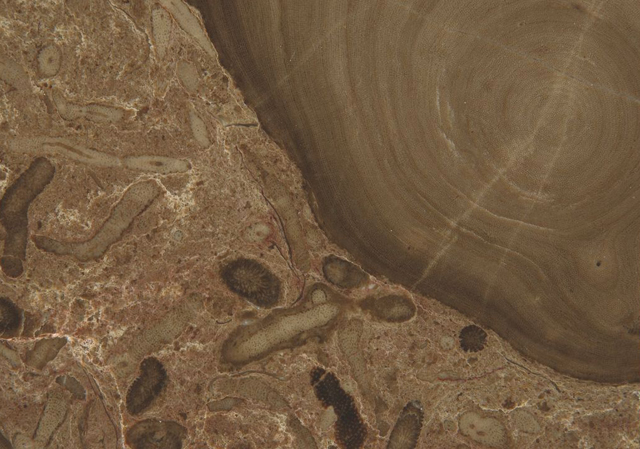THE ŚWIĘTOKRZYSKIE MARBLES

The Chęcińy-Kielec Landscape Park has a very important place in Polish mining industry, considering the variety of mined materials and various traditions in which they have been used. Limestone, that is normally called marble, has always been the main material that was quarried there. It is a mineral that was created as a sea sediment in the era of Late and Middle Devonian. Many fossils that are visible on polished or weathered surfaces, are evidence of its origin in the sea. Limestones are carbonate sedimentary rocks. From the petrological perspective, they are not marbles because they have not undergone the process of metamorphosis. Technically speaking, they are marbles because after polishing they gain a shiny look and a decorative, often patterned colour.
Main localities for marble quarrying were the quarries Bolechowice, Szewce, Góra Zamkowa in Chęciny, Góra Zelejowa, Ołowiance, Rzepce and Miedziance, outside of the Landscape Park also: Słopec Szlachecki not far from the village Daleszyce, Górna and Łagów.
The existence of many, often not very big quarries, where limestones of different colours and structures were quarried, was characteristic for the quarrying around the village Kielce. In this way, many different varieties were obtained, especially in shades of grey and brown. They can also be differentiated by the type of fossils and by often present calcite applications. This diversity is the main characteristic which makes it possible even today to identify the correct material which certain architectural elements of various historical buildings are made from.
When describing the marbles of Kielce used in architecture, we can today only talk about historical buildings. Their golden age is already over and they have left traces only in the legacy of old times.
The building that is best known in Kielce for the use of architectural details that come from the factory “Marmury” in Kielce, is the House of Physical Education and Sport of Marshal Józef Piłsudski built in 1935 in the street Ściegiennego. Currently, it is the seat of the Regional Cultural Centre. Material quarried from the deposits in Bolechowice, Szewce, Zygmuntówka, Ołowianka, Jaźwica, and Morawica, was used in the decorations of the interiors.
A characteristic feature of the limestone of Bolechowice is its white-grey colour and also fossils. Especially the Amphiporus, similar to small earthworms, and Stromatoporoids, similar in shape to little cauliflowers, are dominating.
The main altar in church of St. Charles Borromeo in Karczówka in Kielce is decorated with the marble of Bolechowice. Other elements in this church, made from the same material, are also worth the attention: portal from the chancel to the sacristy and staircase located in the choir loft at the main entrance to the church. The material for the paving in the Holy Trinity Church in Kielce was also obtained in Bolechovice. In this case, the marble from Bolechovice is combined with geologically younger Jurassic limestone of light pink colour from Morawice. There are also several marble epitaphs and aspersoriums made from the limestone from Bolechowice, in the Holy Trinity Church.

Another place with architectural details from the marble from Bolechowice, is the Basilica Minor in Kielce, that stands on the Cathedral Hill. Two marble portals that lead to the temple from the Northern and Western side, were made in the years 1632 – 1635 from the initiative of Cardinal Jan Albert Waza, son of Sigismund III.
The current state of preservation of these portals is the result of not very lucky choice of this material for the decoration of outside elements of the church. There, there material is exposed to all of the weather conditions. Although the details of the profiling have been preserved well, the whole portal is today covered with light grey patina which hides the beauty of marble.
Based on the historical records on the location of 42 historical and active marble quarries in Świętokrzyskie Voivodeship, the author has compiled a collection of articles that illustrates the beauty and variety of these marbles which have been the pride of this region for several centuries.

Source: Kurier kamieniarski
Author: Jerzy Jędrychowski | Published: 07.03.2017
